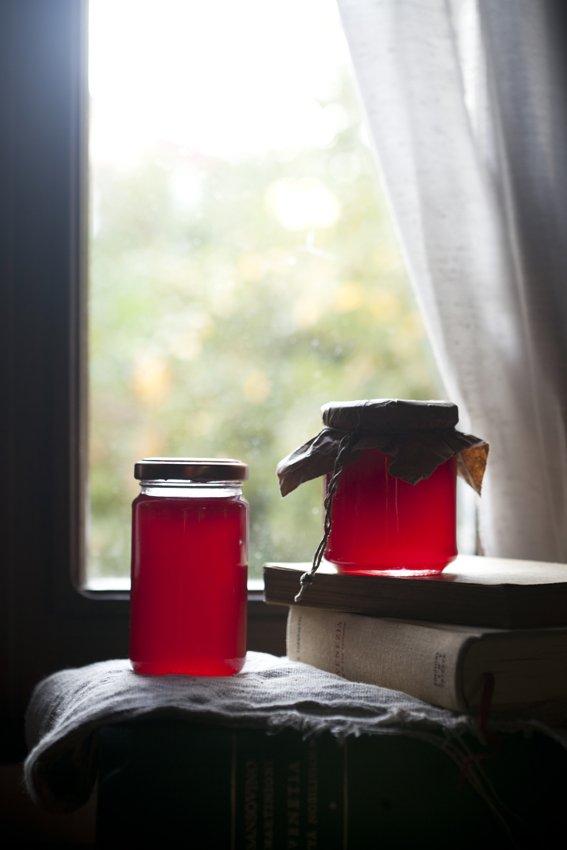Pomegranate Syrup
Dorina’s Ruby Red Potion
Opening the fridge in my mother's kitchen, one can come across some strange things.
Once, I nearly filled my sandwich with some rabbit glue because I had mistaken it for mustard! Yes, rabbit glue! This is what might be inside the fridge of two “alchemist sorcerers” who like to prepare their own painting colors using strange and ancient recipes!
Exactly as the old Venetian painters in the 1500s and beyond used to do, Dorina and Luciano, my parents, use the almost forgotten knowledge of natural color making for making their own paint. But, as it usually happens, I had to put my hands on the most hidden jar in the fridge, the less inviting one, the one with a dubious color. What a mistake! A horrible smell spread rapidly in the whole kitchen, so much so, that I had to go outside to breathe some fresh air.
“What on earth is this revolting thing?!” I asked Dorina while I yearned for a gas mask.
“It’s Tempera grassa, don’t you see it?” she replied with an expression on her face as if it was the most obvious thing in the world. Silly me. Why ask such a question? I should have known that looking for mustard in the fridge was something far too ordinary for this house!
Tempera grassa – in Dorina’s fridge there is always plenty of it – it’s used for making natural paint and it’s a paste made of eggs, flour, linseed oil, animal glue, and a few other ingredients. Just imagine the smell of it. This type of mixture, for which there are several variations, was the secret for that rich and textured painting created by artists such as Titian or Veronese, and maybe, it might also have been the secret for those bright shades that some of the Old Masters such as Van Eyck, for example, used so well in their paintings. And so, while I’m holding the jar containing the mixture, and although I’m annoyed for not having my mustard, I’m also thinking that maybe I’m quite lucky to know such things that other people might not know.
Thus, the day I noticed a jar containing some very bright ruby-red liquid among other suspicious vials, I immediately thought it was another strange mixture to be used on the canvas Dorina was painting. Not having any emergency breathing equipment, I restrained myself from opening the jar and went for a yogurt instead. Yes, it was real yogurt, I’m sure it was.
Then I went to my mum’s studio. She had her rubber boots on and her hands were stained in red. “Mum. Have you killed someone?” I asked her adding with an experienced look: “Nice color that vivid red varnish in the fridge!”
“Would you like some of it in your yogurt?” Dorina asked me, while I was already laughing thinking that she was making fun of me. “It’s very good, you know. I’ve made it this afternoon with the pomegranates we have in the garden.”
“Are you kidding?!!…isn’t it for painting?”
These are some of Dorina’s potions… and which one had I almost eaten? The no-edible one, of course!
I put on my rubber boots and together we went out to pick the last of the pomegranates. These Autumn colors are simply amazing. The garden is sparkling with splashes of colors as in one of Dorina’s canvases.
I like to know the correct name of the varieties of reds which are all different from each other. There is the chrome red, cochineal red, carmine red, and even bloody red which is the color of the juice we’ve squeezed out of the pomegranates after having patiently shelled them out. In doing this we have also stained the walls in my kitchen and now it looks like a murder scene... Luckily, there are only some little marks. Thanks to a method Dorina told me about, this pure juice, full of vitamins and antioxidants, becomes a syrup and can be stored for months. It’s perfect to sweeten yogurt or used on pancakes or crepes as an alternative to maple syrup.
While the evening mist has started to wrap the garden and its bright colors, the ruby red potion has started to slightly simmer. It will soon be ready to be put into the jars and preciously stored as will be the memory of this afternoon spent with my mom.
POMEGRANATE SYRUP
Ingredients:
*Note: the proportion of juice/sugar is 50%, therefore it depends on the amount of juice you obtain from your pomegranates. When the syrup is hot it's quite liquid but once cold, it will thicken.
To make about 750 ml of syrup - 5 jars of 150 ml each:
• 500 ml of pure pomegranate juice (I've used 4 big ripe pomegranates).
• 500 g sugar
Instructions:
1. Use some glass jars with lids, making sure they are perfectly clean and dry.
2. Shell the pomegranates and put their cleaned seeds into a bowl. You should make sure that there aren't any white bits from the peeling.
3. Use a potato masher or a vegetable mill and squeeze the juice out of the seeds into a high-edged pot. Squeeze the seeds more than once so as to extract as much of the juice as possible.
4. Add the sugar and put over a high heat. Bring to a boil and turn the heat off.
5. Fill the jars with the hot syrup, put the lids on, and close well. Put the jars under a blanket to let them cool down slowly and to vacuum-sealed them. Do not take the blanket off until the cooling process is over.






